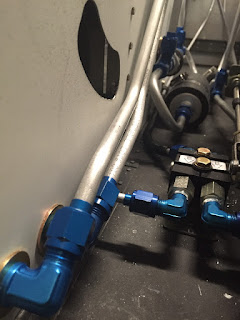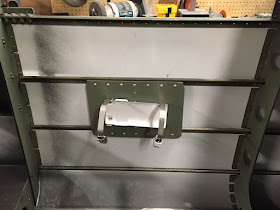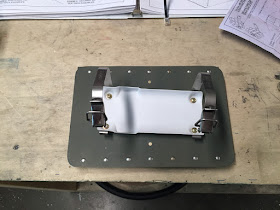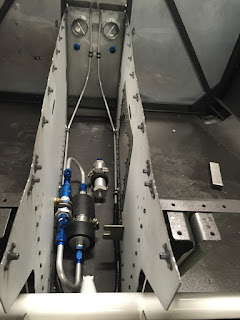Happy Veterans Day! It's been an interesting year, getting used to my new job where we observe all of the federal holidays and have the day off. Not that I'm complaining of course... more time to build! :-)
Today was an excellent day making progress in a number of areas. I started off by installing the ELT mount in the tailcone, which went fairly quickly even though it was a bit tough getting access to install blind rivets in all the holes between the mount and the J-stringers behind it. I ended up stacking two #6 locknuts on the rivet stems so that my rivet puller could get the grip it needed for the job. About 20 minutes of this combined with some awkward leaning, and the mount was in!
ELT mount installed, sans ELT
ELT mount installed, with ACK E04 ELT
Cool! Looks "official" now. You may notice that the mounting tray is not parallel with the tailcone stringers. I'm using the door sills as a reference for level, and discovered that the stringers in this location actually slant upwards just slightly. I used a level to approximate the angle here, and I believe it turned out pretty darn close. I have a 10-degree tolerance per the installation requirements anyway, and I'm confident that it's well within that. (EDIT 11/15/2015: A tip I later discovered, kind of an "oh, duh!" moment: if you have a smartphone like an iPhone with a compass/level app, you can use it as an inclinometer and get very accurate measurements to the nearest degree! Turns out this ELT is approximately 2 degrees off from perfection. Well within tolerance, but I could have done it perfectly if I had been thinking!)
Next on the agenda was to start assembling the flap system. Oops! Quickly discovered that before I do any final installation in this area, I'll need to install my belly-mount COM antenna doubler that I want to put in this location. So, on to that.
I chose this location for the antenna for a couple reasons. First, I wanted the antenna to be in the tunnel area so that it is always accessible from the inside. I've seen a number of builders (the majority, in fact) use the area under the rear seat to mount a COM antenna, but that just doesn't sit well with me. If you ever have to gain access to this area for whatever reason, you'll be drilling out hundreds of rivets and removing a pretty large part of the cabin floor. So I made the decision early on to put all the belly antennas in the tunnel area (I think there will only be two: this COM antenna, and a transponder antenna further forward).
The second reason for choosing this *exact* location in the tunnel beneath the flap torque tube is a bit of accidental chance. Way back when we were first joining the forward and mid fuselage sections together, Sarah had a bit of an "oops" moment with the tungsten bucking bar, which had slipped from her hand and went flying through the air. In a slow-motion "noooooooooo!" sequence, fate steered the bucking bar's trajectory straight toward this area of the tunnel, resulting in a solid "clunk!" and producing a nasty outwards dimple in the bottom skin. We learned two things from this event: (1) Install an antenna in this location; and (2) secure the bucking bar to Sarah's hand with duct tape. Just kidding, of course. We weren't actually sure if we would install an antenna here yet ;-)
Reading some of the other build blogs online, I discovered that fellow RV-10 builder Justin Twilbeck actually had a similar mishap (
see his blog post "Dent Happens" here) and decided to put an antenna at the scene of his accident as well! Funny coincidence.
Anyway, this location actually works out perfectly, as it is right at the "hip" of the fuselage, at the aft-most part of the bottom before it takes a turn upwards. I believe it really is actually an ideal location. So, I got started on making a doubler to place over it. I found a template for the hole pattern for the Comant CI-122 and used it to start making the doubler, and ended up with this part:
Comant CI-122 doubler, prior to enlarging circled holes for antenna connector and mounting screws (also added another row of holes near the left side in this photo)
After a bit of match-drilling to the fuse bottom skin and enlarging the holes, I was able to shoot the piece with primer quickly and await Sarah's return home from work to finish dimpling and riveting the piece into place. In the meantime, I continued with some miscellaneous tasks left over from the previous sections, including running some conduit along the right side of the baggage area and installing the cover panel, as well as installing the cover panel on the left side of the baggage area behind the rear seats. Lastly, I installed a number of nutplates that go in the various locations along the interior of the fuselage to secure cover panels and such. About this time, Sarah got home and we proceeded to dimple the bottom skin and rivet the antenna doubler into place:
Antenna doubler installed in tunnel. Antenna is offset slightly to provide clearance for elevator push rod, visible on the right
Comant CI-122 screwed to the bottom of the fuselage
Looks neat! I didn't have long enough screws for a permanent installation, but they worked perfect for a trial fit. Seems pretty solid and sturdy here and should work great!
For the final chapter today, I finally got to what I had set out to do earlier today, which is to install the flap system. I had already drilled and prepped most of the parts on a previous day, so today it was really just all about installing everything into the plane. I quickly discovered my first issue, which was that the holes in the fuselage side skin were too small to fit the flap torque tubes. I couldn't figure out any other way to get both tubes into place, and ended up enlarging the skin to match the underlying holes at 1-1/16". Then the next challenge was installing the UHMW bushings and getting everything oriented properly. I discovered another problem: the cutaways for the powdercoat weren't exactly in the correct locations on the torque tubes! This caused a huge increase in friction, and the tubes were very difficult to rotate.
L torque tube inner end, line drawn where bushing extends to
Each of the four locations had varying amounts of overlap, so I traced lines on all ends and carefully ground away the powdercoat, and polished the surfaces on the scotch brite wheel afterwards. Re-installing the tubes showed a dramatic reduction in friction! Good stuff.
So after about an hour of bolt-installation and rigging, we had the whole works put together!
Sarah is happy. Please move your hand though so we can see!
There we go! Flap system installed and ready to go
Sarah wanted to take a picture of me tightening the last bolt holding the actuator to the torque tube arm (visible above with no nut)
With that, we were able to hook a drill battery up to the flap motor and presto... The flap arm appears to work perfectly!! Wahoo! This is the first electrical part that is permanently installed to the airframe now. Exciting times. We ran the flaps up and down a couple times until the excitement wore off a bit and decided to call it a night. Big day of building today, and all ended up going very well! Tomorrow if the UPS gods are shining on us we should get some more fittings to satisfy our insatiable appetite for Aircraft Spruce packages, and we can continue with the fuel system. Maybe we'll also get to install more of the control system, even the control sticks! 'Stick' around!!





















































